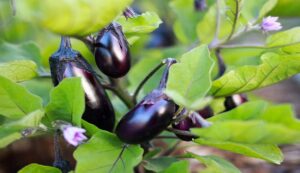Brinjal Farming: Cultivate brinjal in rain, you will get bumper profit at low cost
Brinjal Farming: Nowadays, Saurashtra farmers are quickly switching to growing brinjal during the monsoon season. Compared to the summer, this crop produces more during the rainy season, and there is a significant market demand for it. Farmers are making millions of rupees from farming because of this.

Brinjal is a low-cost crop that yields higher profits
Farmers may make a healthy profit from brinjal even at minimal cost by using scientific procedures. The J.D. Horticulture Department states that the ideal soil for brinjal production is medium black or reddish brown. To make the soil friable and allow for healthy plant growth, the field should be plowed thoroughly two or three times. In the final plowing, the soil is further fertilized by adding 20 to 25 tons of organic manure or micronutrients per acre.
The secret to making money is selecting the appropriate kind
When growing brinjal, variety selection is crucial. During the monsoon season, Gujarati cultivars such as GAOB-2, GAOB-3, JC-1, JC-2, Arka Nidhi, and Arka Keshav produce well. In addition, farmers benefit from increased production and profit from hybrid types like Mahyco and Nunhems.
Appropriate seedling preparation time and technique
In late June or early July, eggplant seedlings are ready. One guntha (1000 square meters) of field requires 100 to 150 grams of seeds. To prevent plant infections, fungicidal medications such as Trichoderma or Thiram should be administered to the seeds prior to planting. The plants are prepared for transplanting in around 25 to 30 days.
Remember these things while getting a transplant
Transplanting eggplant is thought to be most effective between July and August. For local types, plants should be planted 60 x 60 cm apart, whereas hybrid varieties should be put 75 x 60 cm apart. As a result, the plants may grow freely and produce well.
Irrigation and drainage are crucial
The field may have waterlogging as a result of the monsoon’s surplus water, which might harm the plants. As a result, the field needs a solid drainage system. To ensure that the crop receives enough water and that no water is wasted, irrigation should be carried out as needed.
Use of fertilizers must be balanced
100–120 kg of nitrogen, 60 kg of phosphorus, and 60 kg of potash are needed for one hectare of field. When transplanting, add one-fourth of the phosphate, potash, and nitrogen; the remaining nitrogen should be administered in two to three installments. This promotes healthy plant development and boosts production.

